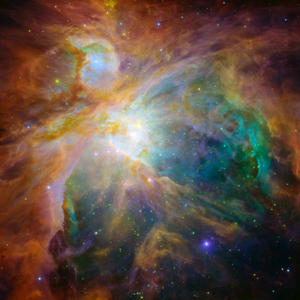Jun. 15, 2018 Research Highlight Physics / Astronomy
Radio telescopes reveal the cradle of a star cluster in the Orion A cloud
A cloud of dust and gas in the Orion constellation contains several dense regions that will collapse to ignite multiple stars
 Figure 1: A false-color image of the Orion Nebula (upper left corner) and the tip of the Orion A cloud taken by NASA’s Spitzer Space Telescope. © 2018 NASA
Figure 1: A false-color image of the Orion Nebula (upper left corner) and the tip of the Orion A cloud taken by NASA’s Spitzer Space Telescope. © 2018 NASA
A stellar nursery in the constellation of Orion appears to be on the verge of birthing a cluster of new stars, observations by RIKEN astronomers suggest1. While it will probably take several hundreds of thousands to millions of years before stars are formed, such time scales are a mere blink of an eye in cosmological terms.
Stars form as gravity slowly pulls dust and gas into dense ‘condensations’, squeezing them until the mounting pressure triggers nuclear fusion reactions that ignite a newborn star. But many aspects of this genesis remain mysterious, especially when more than one star is born.
“More than half of all stars are formed as multiple star systems,” notes Satoshi Ohashi of RIKEN’s Star and Planet Formation Laboratory. “However, the process by which multiple stars are formed is not yet understood.”
Using two radio telescope arrays in Chile and observations from the European Space Agency’s Herschel Space Observatory, Ohashi and his colleagues have studied TUKH122, a region of dust and gas in the Orion A cloud, which is one of the best-known star-forming areas in the night sky.
TUKH122 is about 0.3 light years wide, equivalent to about 20,000 times the distance from the Sun to the Earth. The team estimated that the material in TUKH122 amounts to about 29 times the mass of our Sun, and that the temperature of its dust is −261 degrees Celsius, a mere 12 degrees above absolute zero. “This very low temperature indicates that star-forming activity has not started yet,” says Ohashi.
The team found six condensations in TUKH122, each of them many times bigger than our Solar System. The masses of these condensations ranged from 0.1 to 0.4 times the mass of the Sun.
The researchers also mapped the distributions of two molecules in the cloud: diazenylium (N2H+) and methanol (CH3OH). They found that they are not evenly dispersed—diazenylium tends to be concentrated in the central part of the region, whereas methanol is gathered into a shell-like structure that surrounds it. Since methanol is thought to form on the surfaces of dust grains, the team suggested that ultraviolet radiation generated by cosmic rays provides an external energy source that frees methanol from the dust grains.
The observations also revealed that TUKH122’s core is contracting or rotating very slowly and that the molecules experience very little turbulence. This implies that nothing will prevent gravity from eventually causing the condensations to collapse and form stars. “Multiple stars may form in these condensations in the future,” says Ohashi.
Related contents
- Collisions generate gas in debris disks
- Protostar displays a strange geometry
- Witnessing the birth of a star
References
- 1. Ohashi, S., Sanhueza, P., Sakai, N., Kandori, R., Choi, M., Hirota, T., Nguyễn-Lu’o’ng, Q. & Tatematsu, K. Gravitationally unstable condensations revealed by ALMA in the TUKH122 prestellar core in the Orion A cloud. The Astrophysical Journal 856, 147 (2018). doi: 10.3847/1538-4357/aab3d0
